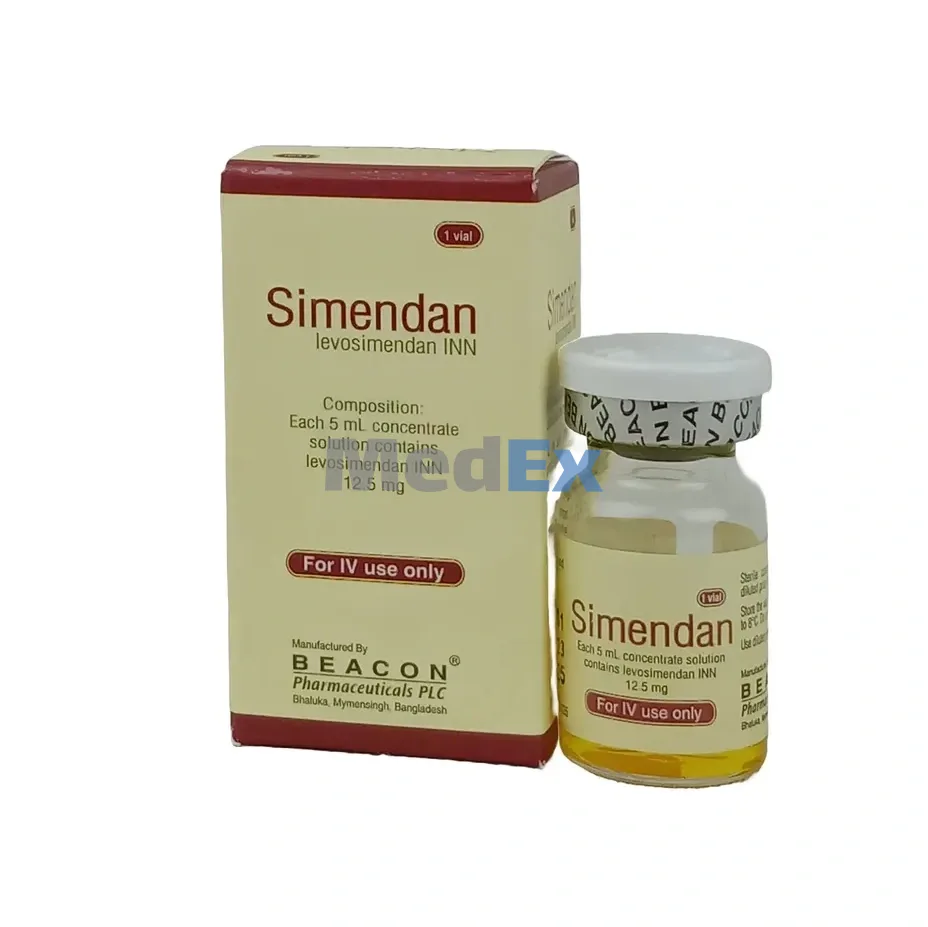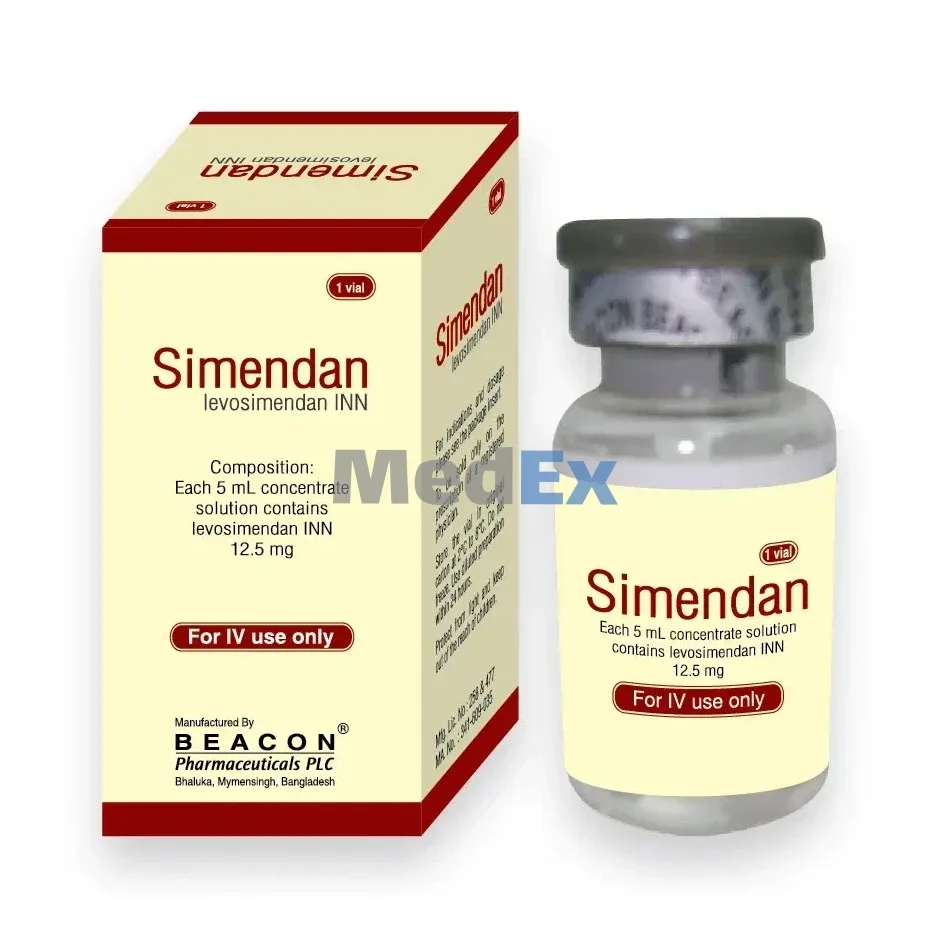5 ml vial:
৳ 4,000.00
Indications
Simendan is indicated for the short-term treatment of acute heart failure (AHF) in situations where conventional therapy is not sufficient, and in cases where inotropic support is considered appropriate.
Dosage & Administration
Levosimendan is for in-hospital use only. It should be administered in a hospital setting where adequate monitoring facilities and expertise with the use of inotropic agents are available.
Method of administration: Levosimendan is to be diluted prior to administration. The infusion is for intravenous use only and can be administered by the peripheral or central route.
Posology: The dose and duration of treatment should be individualised according to the patient’s clinical condition and response. The treatment should be initiated with a loading dose of 6-12 microgram/kg infused over 10 minutes followed by a continuous infusion of 0.1 microgram/kg/min. The lower loading dose of 6 microgram/kg is recommended for patients on concomitant intravenous vasodilators or inotropes or both at the start of the infusion. Higher loading doses within this range will produce a stronger haemodynamic response but may be associated with a transient increased incidence of adverse reactions. The response of the patient should be assessed with the loading dose or within 30 to 60 minutes of dose adjustment and as clinically indicated If the response is deemed excessive (hypotension, tachycardia), the rate of the infusion may be decreased to 0.05 microgram/kg/min or discontinued. If the initial dose is tolerated and an increased haemodynamic effect is required, the rate of the infusion can be increased to 0.2 microgram/kg/min. The recommended duration of infusion in patients with acute decompensation of severe chronic heart failure is 24 hours. No signs of development of tolerance or rebound phenomena have been observed following discontinuation of Levosimendan infusion. Haemodynamic efects persist for at least 24 hours and may be seen up to 9 days after discontinuation of a 24-hour infusion. Experience of repeated administration of Levosimendan is limited. Experience with concomitant use of vasoactive agents, including inotropic agents (except digoxin) is limited In the REVIVE programme, a lower loading dose (6 micrograms/kg) was administered with baseline concomitant vasoactive agents.
Monitoring of treatment: Consistent with current medical practice, ECG, blood pressure and heart rate must be monitored during treatment and the urine output measured. Monitoring of these parameters for at least 3 days after the end of infusion or until the patient is clinically stable is recommended. In patients with mild to moderate renal or mild to moderate hepatic impairment monitoring is recommended for at least 5 days.
Elderly: No dose adjustment is required for elderly patients.
Renal impairment: Levosimendan must be used with caution in patients with mild to moderate renal impairment. Levosimendan should not be used in patients with severe renal impairment (creatinine clearance <30 ml/min).
Hepatic impairment: Levosimendan must be used with caution in patients with mild to moderate hepatic impairment although no dose adjustment appears necessary for these patients. Levosimendan should not be used in patients with severe hepatic impairment.
Children: Levosimendan should not be administered to children and adolescents under 18 years of age.
Method of administration: Levosimendan is to be diluted prior to administration. The infusion is for intravenous use only and can be administered by the peripheral or central route.
Posology: The dose and duration of treatment should be individualised according to the patient’s clinical condition and response. The treatment should be initiated with a loading dose of 6-12 microgram/kg infused over 10 minutes followed by a continuous infusion of 0.1 microgram/kg/min. The lower loading dose of 6 microgram/kg is recommended for patients on concomitant intravenous vasodilators or inotropes or both at the start of the infusion. Higher loading doses within this range will produce a stronger haemodynamic response but may be associated with a transient increased incidence of adverse reactions. The response of the patient should be assessed with the loading dose or within 30 to 60 minutes of dose adjustment and as clinically indicated If the response is deemed excessive (hypotension, tachycardia), the rate of the infusion may be decreased to 0.05 microgram/kg/min or discontinued. If the initial dose is tolerated and an increased haemodynamic effect is required, the rate of the infusion can be increased to 0.2 microgram/kg/min. The recommended duration of infusion in patients with acute decompensation of severe chronic heart failure is 24 hours. No signs of development of tolerance or rebound phenomena have been observed following discontinuation of Levosimendan infusion. Haemodynamic efects persist for at least 24 hours and may be seen up to 9 days after discontinuation of a 24-hour infusion. Experience of repeated administration of Levosimendan is limited. Experience with concomitant use of vasoactive agents, including inotropic agents (except digoxin) is limited In the REVIVE programme, a lower loading dose (6 micrograms/kg) was administered with baseline concomitant vasoactive agents.
Monitoring of treatment: Consistent with current medical practice, ECG, blood pressure and heart rate must be monitored during treatment and the urine output measured. Monitoring of these parameters for at least 3 days after the end of infusion or until the patient is clinically stable is recommended. In patients with mild to moderate renal or mild to moderate hepatic impairment monitoring is recommended for at least 5 days.
Elderly: No dose adjustment is required for elderly patients.
Renal impairment: Levosimendan must be used with caution in patients with mild to moderate renal impairment. Levosimendan should not be used in patients with severe renal impairment (creatinine clearance <30 ml/min).
Hepatic impairment: Levosimendan must be used with caution in patients with mild to moderate hepatic impairment although no dose adjustment appears necessary for these patients. Levosimendan should not be used in patients with severe hepatic impairment.
Children: Levosimendan should not be administered to children and adolescents under 18 years of age.
Interaction
Consistent with current medical practice, Simendan should be used with caution when used with other intravenous vasoactive medicinal products due to a potentially increased risk of hypotension. No pharmacokinetic interactions have been observed in a population analysis of patients receiving digoxin and Simendan infusion. Simendan infusion can be used in patients receiving beta-blocking agents without loss of efficacy. Co-administration of isosorbide mononitrate and Simendan in healthy volunteers resulted in significant potentiation of the orthostatic hypotensive response.
Side Effects
In placebo-controlled clinical trials for AHF (REVIVE programme), 53% of patients experienced adverse reactions, the most frequent of which were ventricular tachycardia, hypotension, and headache. In a dobutamine-controlled clinical trial for AHF (SURVIVE), 18% of patients experienced adverse reactions, the most frequent of which were ventricular tachycardia, atrial fibrillation, hypotension, ventricular extrasystoles, tachycardia, and headache.
Pregnancy & Lactation
There is no experience of using levosimendan in pregnant women. Animal studies have shown toxic effects on reproduction. Therefore, levosimendan should be used in pregnant women only if the benefits for the mother outweigh the possible risks to the foetus. It is not known whether levosimendan is excreted in human milk. Studies in rats have shown excretion of levosimendan in breast milk, therefore women receiving levosimendan should not breastfeed.
Precautions & Warnings
An initial haemodynamic efect of Simendan may be a decrease in systolic and diastolic blood pressure, therefore, Simendan should be used with caution in patients with low baseline systolic or diastolic blood pressure or those at risk for a hypotensive episode. More conservative dosing regimens are recommended for these patients. Physicians should tailor the dose and duration of therapy to the condition and response of the patient. Severe hypovolaemia should be corrected prior to Simendan infusion. If excessive changes in blood pressure or heart rate are observed, the rate of infusion should be reduced or the infusion discontinued. The exact duration of all haemodynamic efects has not been determined, however, the haemodynamic effects, generally last for 7-10 days. This is partly due to the presence of active metabolites, which reach their maximum plasma concentrations about 48 hours after the infusion has been stopped. Non-invasive monitoring for at least 4-5 days after the end of infusion is recommended. Monitoring is recommended to continue until the blood pressure reduction has reached its maximum and the blood pressure starts to increase again, and may need to be longer than 5 days if there are any signs of continuing blood pressure decrease, but can be shorter than 5 days if the patient is clinically stable. In patients with mild to moderate renal or mild to moderate hepatic impairment an extended period of monitoring maybe needed. Simendan should be used cautiously in patients with mild to moderate renal impairment. Limited data on the elimination of the active metabolites are available in patients with impaired renal function. Impaired renal function may lead to increased concentrations of the active metabolites, which may result in a more pronounced and prolonged haemodynamic effect. Simendan should be used cautiously in patients with mild to moderate hepatic impairment. Impaired hepatic function may lead to prolonged exposure to the active metabolites, which may result in a more pronounced and prolonged haemodynamic effect. Simendan infusion may cause a decrease in serum potassium concentration. Thus, low serum potassium concentrations should be corrected prior to the administration of Simendan and serum potassium should be monitored during treatment. As with other medicinal products for heart failure, infusions of Simendan may be accompanied by decreases in haemoglobin and haematocrit and caution should be exercised in patients with ischaemic cardiovascular disease and concurrent anaemia. Simendan infusion should be used cautiously in patients with tachycardia atrial fibrillation with rapid ventricular response or potentially life-threatening arrhythmias. Experience with repeated administration of Simendan is limited. Experience with concomitant use of vasoactive agents, including inotropic agents (except digoxin), is limited. Benefit and risk should be assessed for the individual patient. Simendan should be used cautiously and under close ECG monitoring in patients with ongoing coronary ischaemia, long QTc interval regardless of etiology, or when given concomitantly with medicinal products that prolong the QTc interval. The use of Simendan in cardiogenic shock has not been studied. No information is available on the use of Simendan in the following disorders: restrictive cardiomyopathy, hypertrophic cardiomyopathy, severe mitral valve insufficiency, myocardial rupture, cardiac tamponade, and right ventricular infarction Simendan should not be
administered to children as there is very limited experience of use in children and adolescent under 18 years of age. Limited experience is available on the use of Simendan in patients with heart failure after surgery, and insevere heart failure in patients awaiting heart transplantation.
administered to children as there is very limited experience of use in children and adolescent under 18 years of age. Limited experience is available on the use of Simendan in patients with heart failure after surgery, and insevere heart failure in patients awaiting heart transplantation.
Overdose Effects
Overdose of Simendan may induce hypotension and tachycardia. In clinical trials with Simendan, hypotension has been successfully treated with vasopressors (e.g. dopamine in patients with congestive heart failure and adrenaline in patients following cardiac surgery) .
Therapeutic Class
Positive Inotropic drugs
Storage Conditions
Store in a refrigerator (2˚C-8˚C) Do not freeze. The color of the concentrate may turn to orange during storage, but there is no loss of potency and the product may be used until the indicated expiry date if storage instructions have been followed. For storage conditions of the diluted medicinal product.
Pack Images: Simendan 12.5 mg Injection



